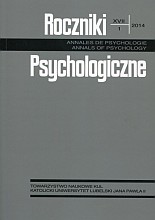The Chameleon Effect and the Stereotypes of Nonbelievers Held by Religious Persons
The Chameleon Effect and the Stereotypes of Nonbelievers Held by Religious Persons
Author(s): Wojciech Kulesza, Anna ZgnilickaSubject(s): Psychology
Published by: Towarzystwo Naukowe KUL & Katolicki Uniwersytet Lubelski Jana Pawła II
Keywords: chameleon effect; imitation; stereotype; faith; religion; stereotype modification
Summary/Abstract: The study aimed to verify whether the chameleon effect can be a used as an effective technique of stereotype modification. It has already been shown that individuals whose behaviors were mimicked showed an increased positive disposition as well as readiness to help not only the mimicker but also other people – and, in general, this seems to be an effective tool of social influence. Persons who adjust their behaviors start to act cooperatively. The pilot study presented here, run as a natural experiment, aimed to employ the chameleon effect in order to modify the stereotype of nonbelievers as perceived by participants declaring themselves to be believers. The results showed that even though mimicry positively influenced the perception of the stereotyped group, the scope of the modification was somewhat patchy. This means that the mechanism can be effectively applied as a means for the modification of stereotypes and prejudices within certain limits. Since this is one of the first studies venturing to explore this area, further work is necessary to delineate the abovementioned limits and the applicability of the measures that we discuss in the final part of this paper.
Journal: Roczniki Psychologiczne
- Issue Year: 17/2014
- Issue No: 1
- Page Range: 183-195
- Page Count: 13
- Language: English

